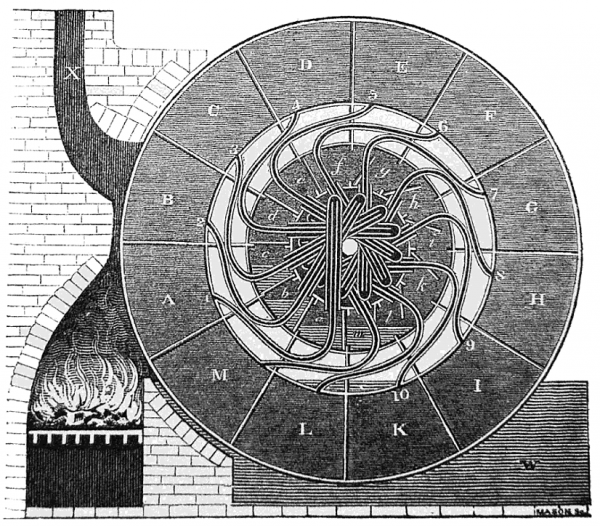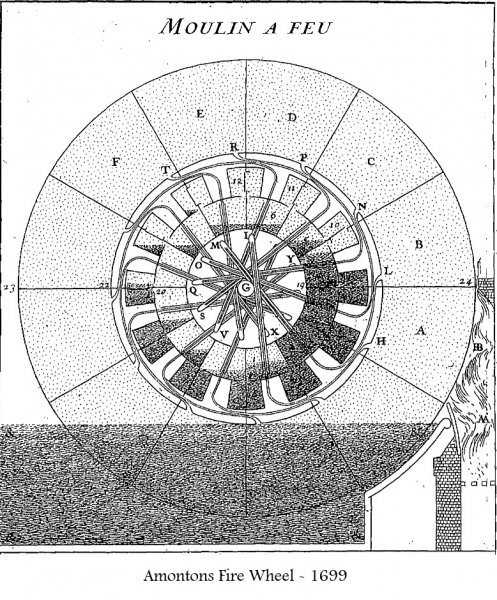Guillaume Amontons
After having tamed water and wind to replace the work of men and horses in using wheels and mills, mankind still had to discover how to use the power of fire to relieve man from physical work.
Since Antiquity several attempts had been done to use the power of heat (from Heron d'Alexandrie on) resulting in highly interesting apparatus. However, while during the middle-age windmills and water wheels flourished in towns and countryside, no machine was operating with fire.
Between 1650-1750, Denis Papin, Edward Somerset, Thomas Savary, Thomas Newcomen opened the way to the steam engine.
Guillaume Amontons, a French physicist, was the first to propose in 1699 a heat-engine, using the expansion of air to provide the motive power. He called his machine a "fire-mill" which was a hot air engine with external combustion using the imbalance of water to generate direct rotation. His objective was clear and the title of his writing is explicit and says it all : "A means of conveniently substituting the action of fire, for the strength of men and horses, to move machines". His machine was meant for being used on an industrial scale.
The fundamental principle leading his invention was to use heat to create mechanical work, which is the principle of all modern heat engine of our days.
Unfortunately, while the steam engine was going to be immensely successful, the early death of the inventor, and the intricacy of the machine, probably, hampered the engine to have the success such a discovery should have had.
Now let's Amontons do the talk
The heat acts very powerfully and very quickly on the air. If it has full freedom to expand, it rarefies it and increases its volume. If it can not extend itself, it will increase the force of its spring (its pressure). If it can extend, but only to a certain extent, the force of its spring is less increased. The cold, on the contrary, tightens the air and diminishes its spring (pressure).
Air having its spring increased by heat will support or elevate a much greater weight than 32 feet of water (10 m) it is bearing usually.
In other words Amontons understood that when air kept at constant volume is heated up, its pressure will increase above the atmospheric pressure. Corollary, when heating up air kept free to expand, the pressure will remain at atmospheric pressure, but the volume will increase.
These are quite basics physical principles, but were only partially known at Amontons' time. He knew about the work of Mariotte (the law of Boyle-Mariotte) but Jacques Charles gave his law on gas expansion only in 1787, and Gay-Lussac's law arrived in 1802.
The great merit of Amontons lies in his novel approach to engines, showing that he understood the general principles of the behavior of air when heated up, though intuitively and through experiments, and in constructing a hot air engine out of it.
He designed, one century before Rev. Stirling, the first external combustion closed-cycle hot air engine in which the same air is used over and over.
Amontons did not use pistons. The piston had just been invented by Denis Papin in 1690. Did Amontons know about it ? In all cases he chose another way to use the expansion force of heated air. He used water instead of a piston.
The beauty of Amontons' invention is not only the heat engine by itself, but also that it was a rotating heat engine, something that hundreds of inventors tried to do without success. With the exception of the turbines and also the Wankel engine, all working heat engines are alternating engines. The rotating engine is theoretically a better engine as all hassle and loss due to linking mechanism is gone. Engines are done for rotating motion and the additional step of alternating motion is only a waste of energy.
Moreover, the fact Amontons used water instead of a piston-cylinder solved a lot of issues that were headaches for all hot air engineers : joint issues.
That does not mean that Amontons machine was a perfect engine. Perfection comes with time and today thermodynamic tells us that an engine like the one of Amontons will use a tremendous amount of fuel, that it will be limited in temperature as the water must not boil, and therefore will have limited performances.
Nonetheless, in 1699, what an invention!
Despite the greatness of his invention, Amontons is not considered as the inventor of the hot air engine. The reason being that his engine is not a piston engine.
But he has been a definitive precursor in believing that heat can be changed in mechanical power to replace manpower.
Nobody did build on Amontons' ideas, and it was only one century later, that Glazebrook invented the first piston hot air engine (patent 1797).
Short description of the Amontons' hot air engine
Amontons' machine consists of a vertical wheel whose axis is horizontal and has two rows of concentric cells or buckets, in equal number, placed at its circumference. The cells of the outer row, which are much larger, are full of air. Those of the inner row, which are on one side and on the lower half of the wheel forming a quarter circle, are full of water. Since there is more weight on this side than on the other side, the wheel rotates until the water is evenly distributed on both sides of the vertical diameter.
In order to make the wheel running, Amontons' idea was to create an imbalance by pushing the water in the upper cells and use its weight to rotate the wheel.
This was done the following way.
The outer cells, each in their turn, all pass on a fire placed at one side of the wheel. In the engraving the fire is on the right side. The air in the cell that passes on the fire is heated and its pressure increases. Through a communication pipe, the heated and compressed air presses the water of a cell of the inner row into a upper cell.
A system of non-return valves prevents water from going into the left cells so that it can go only in the right cells. That way the water can only go upwards. The water gaining gravity brings the wheel into motion, and the wheel rotates from right to left.
Once an outer cell has passed over the fire to increase the pressure of the air which it contained, it will pass into a reservoir, or cistern, full of water. Its air, cooling promptly, recovers its first volumes and retrieves the ability to recommence its action when it passes over the fire again.

